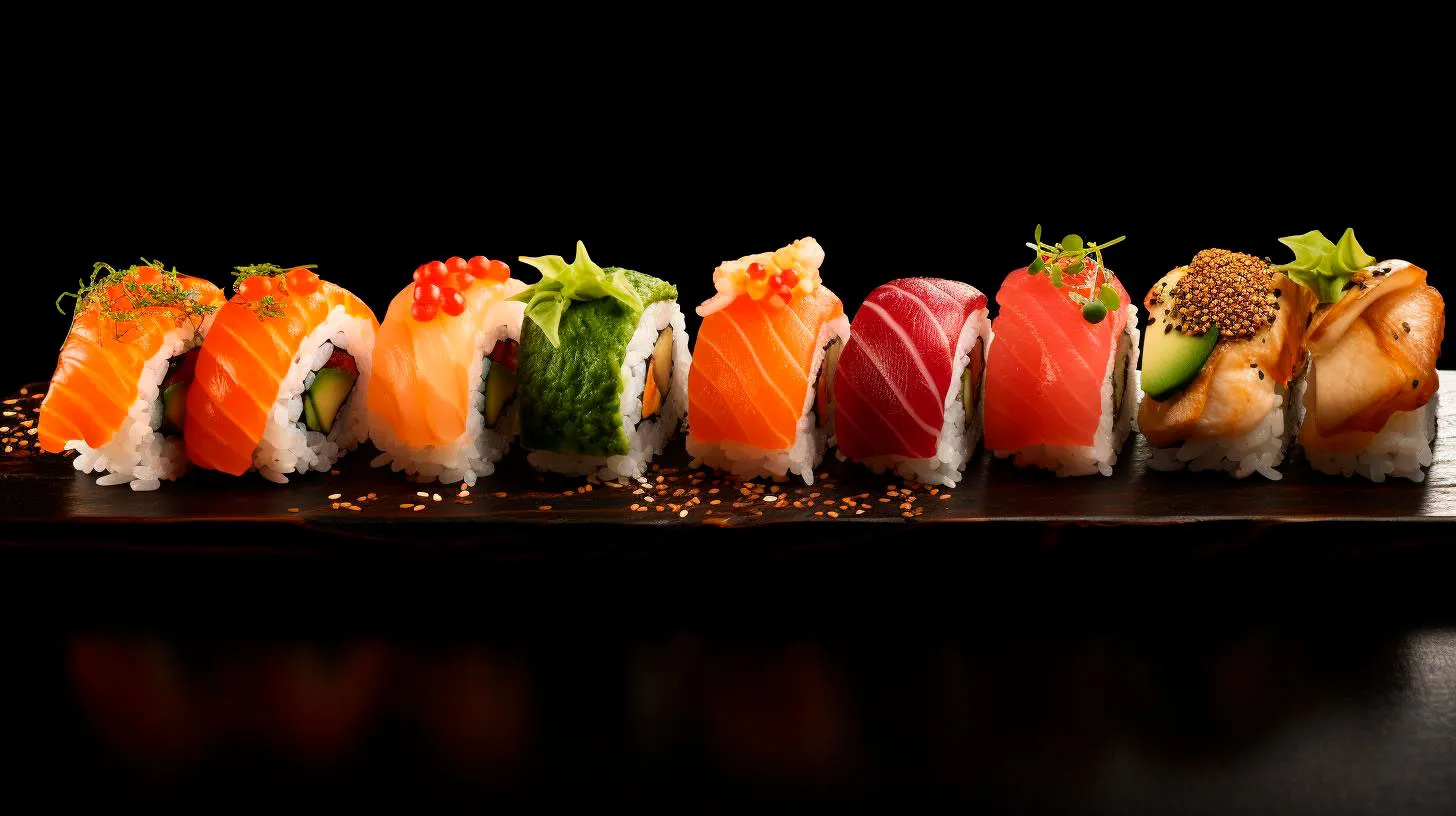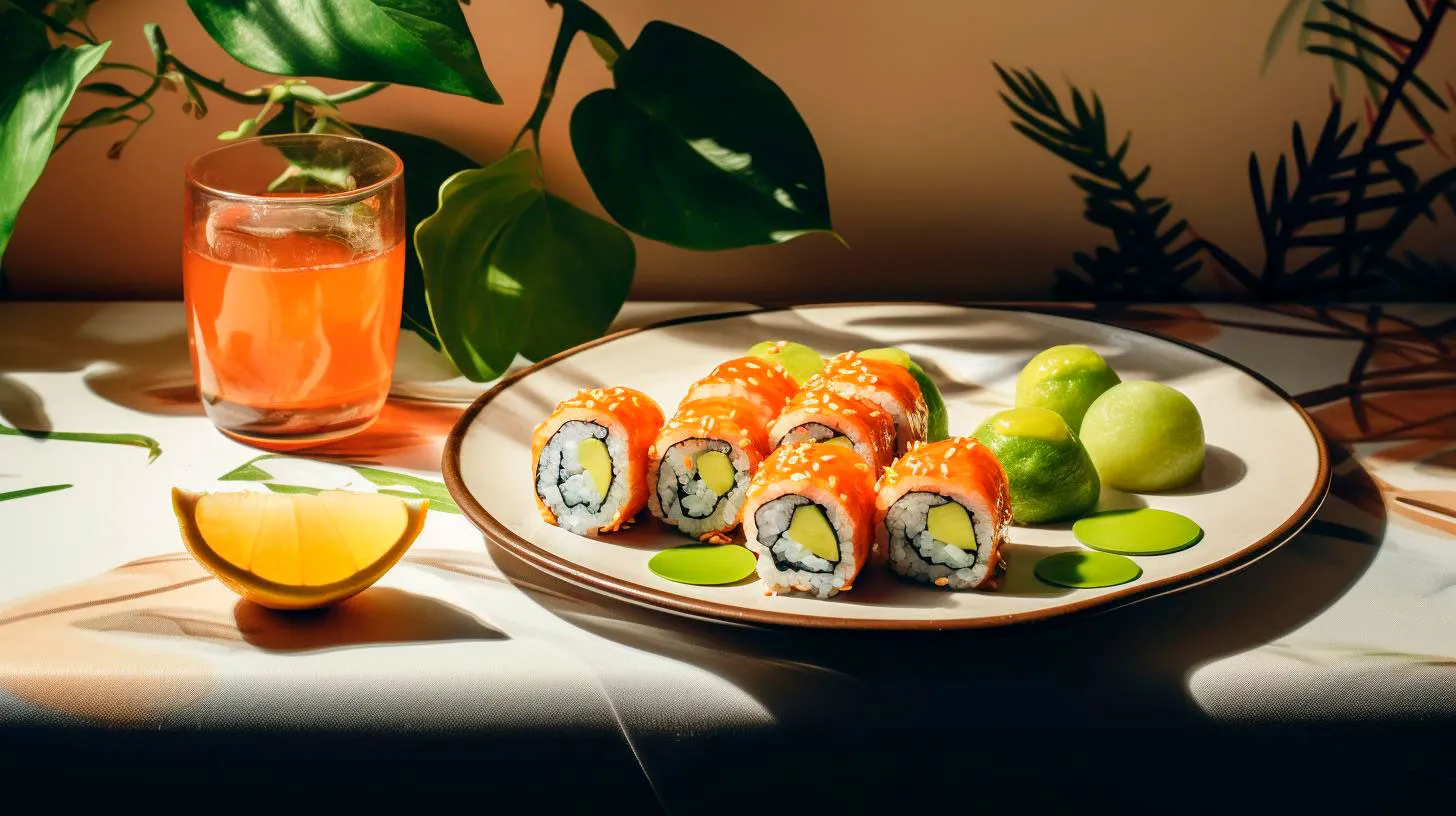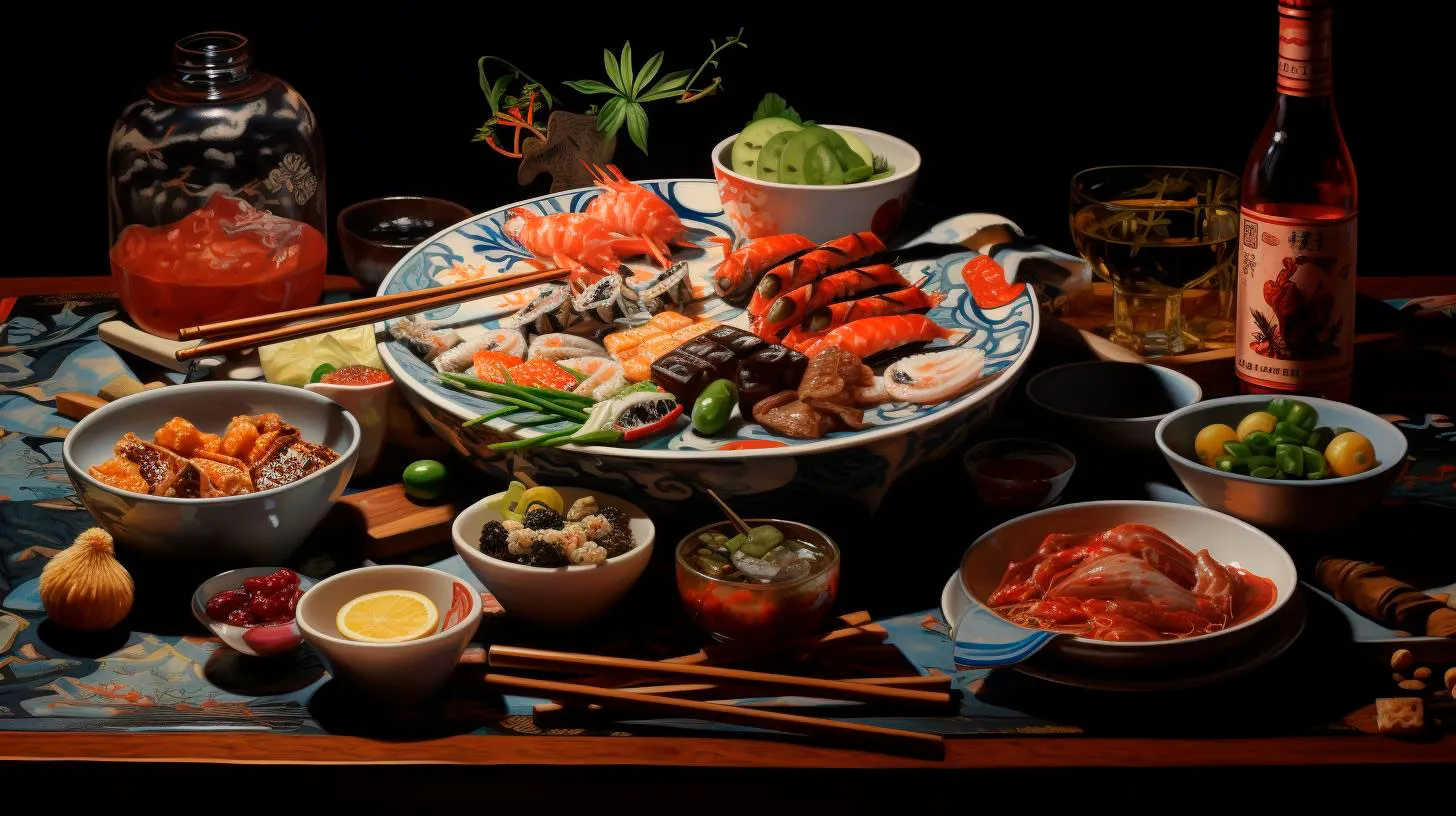Sushi: A Symbolic Gastronomic Journey through Urban Landscapes
From its humble origins to its global prominence, sushi carries a rich history and unique dining experience that has captivated millions worldwide.
The Origin Story
Sushi traces its roots back to Southeast Asia, where ancient cultures preserved fish by fermenting it with rice. This process allowed them to store fish for extended periods, ensuring a sustainable food source. As this preservation method made its way to Japan around the 8th century, it gradually evolved into what we now recognize as sushi.
Initially, sushi was a simple combination of rice and fish. However, over time, chefs began to experiment with different ingredients and techniques, leading to the diverse array of sushi we know today. From nigiri, maki, and sashimi to more modern variations like California rolls and tempura sushi, the world of sushi offers endless possibilities for culinary exploration.
Key Takeaway: History and evolution of sushi
- Sushi originated in Southeast Asia as a way to preserve fish.
- It evolved into its current form in Japan during the 8th century.
- Various sushi types emerged as chefs experimented with ingredients and techniques.
Sushi in Urban Landscapes
As sushi gained popularity, it spread from Japan to major cities around the world, blending seamlessly with urban landscapes. Today, you can find sushi restaurants in virtually every cosmopolitan city, catering to diverse palates and cultural preferences. This globalization of sushi has transformed it into a symbol of culinary fusion and cultural harmony.
Urban dwellers often seek sushi for its freshness, simplicity, and aesthetic appeal. Sushi bars and upscale restaurants provide an immersive experience, with skilled chefs effortlessly crafting delicate rolls, sashimi, and nigiri before their customers’ eyes. Beyond its exquisite taste, sushi is also revered for its health benefits. The use of fresh fish and plant-based ingredients promotes a balanced diet rich in Omega-3 fatty acids, nutrients, and antioxidants.
Key Takeaway: Sushi’s place in urban landscapes
- Sushi restaurants can be found in major cities worldwide.
- Sushi symbolizes culinary fusion and cultural harmony.
- Sushi offers a fresh, healthy, and aesthetically pleasing dining experience.
The Sushi Culture
Sushi is not just a meal; it is a cultural experience that embodies traditional values and customs. In Japan, sushi etiquette is highly regarded, and traditional sushi bars adhere to strict rules and formalities. Whether it’s the use of chopsticks, proper soy sauce usage, or the significance of Wasabi, every aspect of the sushi-eating experience has a deeper meaning.
Moreover, sushi chefs are revered as artists, dedicating years to perfecting their craft. The meticulous preparation, attention to detail, and emphasis on presentation elevate sushi into an art form. This level of craftsmanship ensures that each piece of sushi is not only a treat for the palate but also a feast for the eyes.
Key Takeaway: Sushi as a cultural experience
- Sushi etiquette plays an important role in Japanese culture.
- Sushi chefs are viewed as skilled artisans.
- Attention to detail and presentation elevate sushi into an art form.
Sushi Beyond Boundaries
As sushi continues to evolve, it also pushes the boundaries of culinary creativity. Chefs worldwide experiment with unconventional flavors, fillings, and cooking techniques to create innovative sushi dishes that cater to a diverse range of tastes and preferences. From fusion sushi that combines Japanese and Western elements to vegetarian and vegan sushi options, the possibilities are endless.
Furthermore, sushi has also embraced technology. Sushi conveyor belts and automated ordering systems streamline the dining experience, making sushi accessible and enjoyable for a wider audience. This fusion of tradition and innovation ensures that sushi remains relevant and exciting in the ever-evolving culinary landscape.
Key Takeaway: Innovation and technology in sushi
- Sushi chefs experiment with diverse flavors and cooking techniques.
- Sushi caters to various dietary preferences, including fusion and vegetarian options.
- Technology, such as conveyor belts and automated ordering systems, enhances the sushi dining experience.
In conclusion, sushi’s symbolic gastronomic journey through urban landscapes captures the essence of cultural fusion, culinary artistry, and culinary innovation. From its humble origins to its global prominence, sushi continues to captivate food enthusiasts worldwide. So, whether you are a sushi aficionado or a curious culinary explorer, embark on this gastronomic journey and experience the allure of sushi’s flavors, traditions, and vibrant history.
From Conveyor Belts to Michelin Stars: Urban Tokyo’s Sushi Revolution
The Rise of Conveyor Belt Sushi
Conveyor belt sushi, also known as kaiten-zushi, has been a popular dining option in Japan since its inception in the 1950s. The concept revolutionized the way people enjoyed sushi, providing a fast and affordable dining experience. In urban Tokyo, you’ll find countless conveyor belt sushi restaurants lined up around every corner, offering a convenient and casual way to indulge in this beloved Japanese cuisine.
Key Takeaways:
- Conveyor belt sushi, or kaiten-zushi, offers a fast and affordable dining experience.
- Urban Tokyo is filled with numerous conveyor belt sushi restaurants catering to all budgets.
- Enjoy a convenient and casual sushi dining experience.
The Intersection of Tradition and Innovation
While conveyor belt sushi has its charm, Tokyo’s sushi revolution goes far beyond the automatic dining experience. The city proudly hosts an impressive number of Michelin-starred sushi restaurants, where skilled sushi masters craft exquisite pieces of culinary art.
These renowned establishments, blending tradition with innovation, have propelled Tokyo to the top of the global culinary scene. With their attention to detail, use of the freshest ingredients, and commitment to preserving centuries-old sushi-making techniques, these sushiya have captivated food enthusiasts from around the world. Each bite is a harmonious blend of flavors designed to tantalize both the palate and the senses, leaving a lasting impression.
Key Takeaways:
- Tokyo boasts an array of Michelin-starred sushi restaurants famous for their culinary artistry.
- Preservation of tradition is a key focus, with chefs utilizing fresh ingredients and centuries-old techniques.
- Experience a gastronomic journey that excites both the taste buds and the senses.
The Omakase Experience
A visit to a fine sushi establishment in Tokyo often entails indulging in an omakase experience, where the chef curates a personalized menu based on the freshest ingredients available that day. This intimate dining experience allows patrons to witness the meticulous skill and creativity of the sushi master as they present each carefully crafted piece of sushi.
Patrons can expect a multisensory journey, where flavors harmonize and textures delight. From delicate slivers of fatty tuna to subtly seared scallops, every piece tells a story of the sea, transporting diners to a realm of unmatched culinary bliss.
Key Takeaways:
- Omakase offers a personalized sushi journey curated by the chef.
- Patrons witness the skill and creativity of the sushi master firsthand.
- Delight in a multisensory experience as flavors and textures come together.
Technology Enhancing the Sushi Experience
While sushi-making is steeped in tradition, technology has made its way into the industry, further enhancing the dining experience. Some sushi establishments in Tokyo employ cutting-edge advancements such as automated sushi-making machines and robotic servers, blending innovation with tradition.
Additionally, online platforms and reservation systems have made it easier than ever for locals and tourists alike to secure a coveted seat at the most exclusive sushi spots in Tokyo. These technological advancements have simplified the process of discovering and indulging in the city’s sushi treasures, allowing more people to partake in the culinary revolution.
Key Takeaways:
- Technology has found its place in the sushi industry, enhancing the dining experience.
- Automated machines and robotic servers add a touch of modernity to traditional sushi establishments.
- Online platforms make it convenient for diners to secure reservations at Tokyo’s top sushi spots.
A Sushi Revolution Worth Exploring
Tokyo’s sushi revolution illustrates the perfect balance between tradition and innovation, delivering an unforgettable culinary journey. Whether you opt for a quick and casual conveyor belt sushi experience or embark on an omakase adventure at a Michelin-starred sushiya, Tokyo offers a plethora of options that cater to all tastes and preferences.
So why not immerse yourself in this sushi revolution and discover why the cuisine of urban Tokyo has become a global phenomenon?
Unveiling the Fusion of City Life and Japanese Culinary Traditions
This article aims to dive deeper into the fusion of city life and Japanese culinary traditions, exploring the reasons behind its popularity and the unique qualities that make it so enticing.
The Rise of Japanese Cuisine in Urban Centers
The fusion of city life and Japanese culinary traditions is not a mere coincidence. As urban centers continue to grow and evolve, so do the tastes and preferences of their inhabitants. Japanese cuisine provides a perfect blend of healthy ingredients, intricate flavors, and visually enticing presentation that urban dwellers seek in their fast-paced lives.
Here are some key reasons behind the rise of Japanese cuisine in urban centers:
- Health-consciousness: Japanese cuisine primarily focuses on fresh and nutritious ingredients, ensuring a balanced and healthy meal. With increasing awareness of the importance of a healthy lifestyle, many city dwellers are gravitating towards these wholesome options.
- Unique flavor profiles: Japanese dishes are renowned for their umami flavors, which are derived from ingredients like soy sauce, miso, and seaweed. The exemplary balance of sweet, salty, and savory flavors is an enticing proposition for food lovers seeking new taste experiences.
- Visually appealing presentations: Japanese chefs put immense effort into the presentation of their dishes, creating visually stunning plates that are Instagram-worthy. In our modern digital age, these visually pleasing creations attract attention and become a part of the urban food culture.
- Suitability for different diets: With an increasing number of people adopting vegetarian, vegan, or gluten-free diets, Japanese cuisine has something to offer for everyone. With dishes like vegetable sushi rolls and tofu-based dishes, it caters to diverse dietary preferences.
The Advantages of City Life in Japanese Food Experiences
City life offers numerous advantages when it comes to Japanese food experiences. The dynamic atmosphere, cultural diversity, and accessibility of urban centers create the perfect setting for the fusion of city life and Japanese culinary traditions.
Here are some advantages of city life in Japanese food experiences:
- Availability of diverse ingredients: Cities often have a wide range of specialty stores and markets that offer a vast selection of Japanese ingredients. This ensures that chefs and home cooks have easy access to all the necessary components to create authentic Japanese dishes.
- Exposure to different food cultures: Urban centers act as melting pots of different cultures, bringing people from diverse backgrounds together. This exposure to various food cultures fosters creativity, leading to the fusion of different cuisines with Japanese culinary traditions.
- Emergence of innovative restaurants: Urban centers attract talented chefs who strive to push culinary boundaries and experiment with different flavors. This has led to the emergence of innovative Japanese restaurants that offer unique dining experiences to their patrons.
- Opportunities for immersive experiences: City dwellers have the chance to participate in sushi-making classes, sake tastings, and other Japanese culinary workshops. These immersive experiences allow individuals to connect with Japanese traditions on a deeper level and appreciate the artistry behind the cuisine.
Key Takeaways
The fusion of city life and Japanese culinary traditions has created a gastronomic revolution worldwide. The popularity of Japanese cuisine in urban centers can be attributed to its health-consciousness, unique flavor profiles, visually appealing presentations, and suitability for different diets. City life offers advantages such as access to diverse ingredients, exposure to different food cultures, emergence of innovative restaurants, and opportunities for immersive culinary experiences. As the love for Japanese cuisine continues to grow, urban centers will play a crucial role in shaping its future, pushing the boundaries of what we thought was possible in the world of food.
Exploring the Rich Palette of Japanese Cuisine in Urban Environments
The Rise of Japanese Restaurants in Urban Areas
In recent years, Japanese restaurants have been popping up like mushrooms in urban areas. The allure of Japanese cuisine lies in its unique blend of simple yet sophisticated flavors and its emphasis on fresh, high-quality ingredients. Urban dwellers are increasingly drawn to the authenticity and healthiness of Japanese food, prompting the rise of sushi bars, ramen joints, and izakayas.
- Delectable Sushi: Sushi, the iconic Japanese dish, has become a favorite among urban foodies. Its innovation, style, and unique dining experience make it a must-try for anyone exploring Japanese cuisine.
- Hearty Ramen: Ramen, a comforting bowl of goodness, has gained a cult-like following in urban areas. With its rich broth, chewy noodles, and flavorful toppings, it has become a go-to choice for those seeking a satisfying meal.
- Cozy Izakayas: Izakayas, traditional Japanese gastropubs, offer a casual yet vibrant atmosphere for city dwellers to unwind after a long day. These establishments serve a variety of small plates and drinks, making them perfect for socializing and enjoying a range of flavors.
The Advantages of Japanese Cuisine in Urban Environments
Japanese cuisine seamlessly blends tradition with modern influences, making it a perfect fit for urban environments. Here are some advantages of indulging in Japanese food in the city:
- Healthy and Nutritious: Japanese cuisine is known for its health benefits. It emphasizes fresh, seasonal ingredients and uses cooking techniques that preserve the natural flavors and nutrients of the food.
- Quick and Convenient: Urban dwellers appreciate the efficiency of Japanese cuisine. Whether it’s grabbing a sushi roll for lunch or picking up a bento box for dinner, Japanese food offers a wide array of options for a quick and satisfying meal on the go.
- Vegetarian and Vegan-Friendly: With its emphasis on vegetables and tofu, Japanese cuisine caters well to those with dietary restrictions. Urban environments often have diverse populations with varying preferences, making Japanese cuisine a welcoming choice for everyone.
- Adaptable and Innovative: Japanese chefs are renowned for their creativity and adaptability. In urban environments, they can experiment with fusion dishes, incorporating local ingredients and techniques to create unique culinary experiences.
Key Takeaways
The rich palette of Japanese cuisine has found a comfortable home in urban environments worldwide. Its emphasis on fresh ingredients, health benefits, and unique dining experiences has captivated the hearts and taste buds of city dwellers. As you explore Japanese cuisine in urban areas:
- Experience the art of sushi and the burst of flavors it offers.
- Indulge in the comforting bowl of ramen, perfect for a chilly evening in the city.
- Unwind at an izakaya, savoring small plates and drinks with friends.
- Embrace the health benefits of Japanese cuisine and discover new ingredients.
- Enjoy the convenience and adaptability of Japanese food in your urban lifestyle.
So why not embark on a culinary adventure and explore the rich palette of Japanese cuisine in your city? From traditional dishes to innovative creations, there’s a world of flavors waiting to be discovered.



